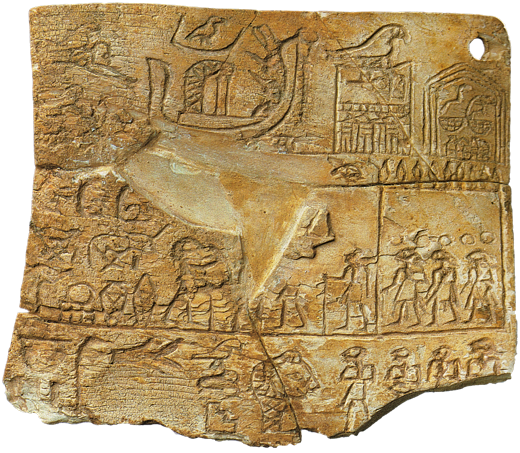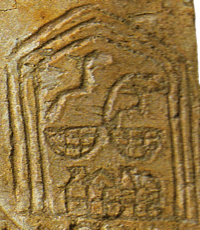The Naqada Label was found at the site of Naqada, in the tomb of Queen Neithhotep, often assumed to have been the mother of Horus Aha. Ever since its discovery in the late 19th century, it has been an important argument in the debates surrounding the identification of Menes.
Two groups of signs, located in the top-right corner of the label, are believed by many researchers to not only mention Menes’ name, but also to give an indication about his identity. The first group can easily be identified as the Horus Name of king Aha. To the right, the second group combines a vulture and a snake, each perched upon a basket, written above a rectangular sign. This second group is written within a booth with a pointed roof.

The Naqada Label seems to represent a visit to a shrine dedicated to the patron goddesses of Upper and Lower Egypt by Horus Aha. The shrine is sometimes seen as the king’s Nebti name, which would identify him with the near-legendary Menes, rather than his predecessor Narmer.
Source: Tiradriti, Egyptian Treasures, p. 42.

The alleged Nebti-name of Menes.
Soon after the discovery of this label, the German Egyptologist Borchhardt identified the second group as the Nebti Name of Menes. The vulture and snake perched upon a basket were taken to symbolise the Nebti title and the rectangular sign below them could be read mn, which, in Greek, could have become Menes. Borchhardt also connected this Nebti Name with the nearby Horus-name of Aha and concluded that Menes was none other than the Horus Aha.
The Naqada label has since often been forwarded as the ultimate proof that Menes is to be identified with the Horus Aha.
Grdsellof, on the other hand, correctly noted that during the 1st Dynasty, it was customary for a king’s Horus and Nebti Names to face each other, which is not the case on the Naqada label. He also pointed to the importance of the fact that the Nebti-name was written within a sign representing a building that he identified as a funerary structure dedicated to the deceased Menes. According to Grdsellof, the Naqada label would thus show the living Aha while attending a funerary ritual performed for the deceased Menes. As the heir of the deceased person normally performed funerary rituals, Menes would need to be identified as Aha’s predecessor, Horus Narmer.
Schott, on the other hand, did not interpret the rectangular sign within the booth as the name Menes at all, but as the verb 'to remain'. For him, the entire group translates to 'The Two Ladies remain', which he interprets as the name of a shrine dedicated to the patron goddesses of Upper- and Lower Egypt. Although he has not provided any arguments when forwarding this hypothesis, several Egyptologists follow it and no longer consider the Naqada Label as evidence about the identity of Menes.
Against the interpretation of the signs in the booth as a Nebti Name, it should be noted that the Nebti Name does not become a standard part of the royal titulary until the reign of Horus Den, several generations after Aha. Neither Horus Djer nor Horus Djet, Aha’s successors, appear to have used this name and if one accepts Grdsellof’s interpretation that the Naqada label provides us with the Nebti Name of Narmer, then Aha too does not appear to have used it.
The apparent absence of Nebti Names before Den’s reign could support Schott’s hypothesis that the Naqada-label does not provide us with a Nebti Name. Several documents from the 1st and 2nd Dynasties confirm the existence of a shrine dedicated to the Two Ladies, symbolised by the signs representing the two goddesses, perched upon a basket, drawn above two buildings. In some cases, this group is written within a sign representing another building. None of these sources, however, mentions the name of this shrine as being 'The Two Ladies remain'. Schott’s hypothesis too, can not be confirmed by other sources.
In conclusion, the Naqada-label has not revealed all of its secrets yet. This is due to the fact that we know too little about the nature of writing in this early period of the Ancient Egyptian history. What is clear is that the label does not in any way provide us with a Nebti Name of a king, let alone that this king would be Menes and that the label would help identify Menes with either Aha or his predecessor Narmer.
